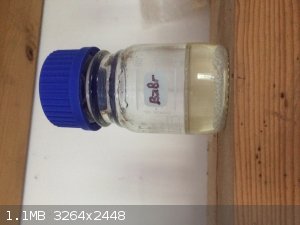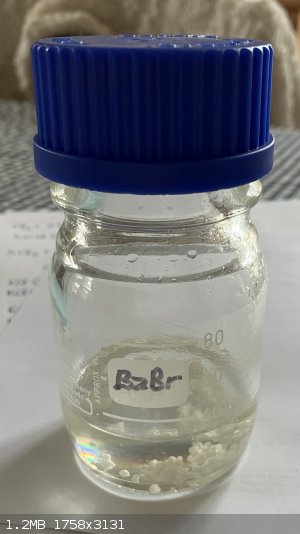Keras
National Hazard
   
Posts: 769
Registered: 20-8-2018
Location: (48, 2)
Member Is Offline
|
|
Quick and partial report on benzyl bromide synthesis
This is a short report on how to make benzyl bromide.
Why benzyl bromide and not benzyl chloride? Because I plan to use it as a Grignard reagent with acetone to synthesise 2-methyl 1-phenyl 2-propanol
(‘phenyl tert-butanol’) which has reportedly a jasmine scent, and apparently its acetic ester is nice to smell, too. Bromine compounds seems to be
better suited to make Grignard reagents.
The benzyl bromide is made the usual way (SN1/2) except 48% HBr is used instead of HCl, which allow for a smaller aqueous phase. In my case I used 50
mL 48% HBr (commercial grade) and 30 mL benzyl alcohol (that is, slightly less than 1 mol of hydrobromic acid, and around 0.3 mol of benzyl alcohol,
so that’s an excess of 3:1 in favour of HBr)
Both reactants are mixed, and the flask is setup for a 90 min reflux. NOTE: be careful to add boiling stones or use stirring. Contrarily to benzyl
chloride, which seems to float atop hydrochloric acid, benzyl bromide is denser (d ~ 1.5) and will fall down as it forms. This might not be evident at
first, because HBr density is almost 1.5 too, but as the acid transforms into water, its density decreases and it moves up. Benzyl bromide ebullition
temp is around 200 °C so there’s a big risk of bumping at the interface.
After 90 min, the reflux is stopped, the product is left to cool then transferred to a sep funnel. The organic phase is the lower one (not evident to
determine, had to use a sample of each to figure out which was which). Discard the upper layer after proper neutralisation (lime stone?) – you might
distill it to recover what's left of 48% HBr if this is precious to you.
The organic layer is washed with sodium bicarbonate. Not much of the acid seemed to make it into the benzyl bromide, very few CO₂ produced if any,
so I deemed that a single washing was sufficient. The 30 mL of impure BnBr are then transferred into a storage vial over calcium chloride, which does
a good job absorbing what little water clouds the liquid.
In phase 2 I will have to distill those 30 mL to see how much is really BnBr. I don’t believe in a quantitative yield, so at least a small part of
it must be either unreacted BzOH or something else.
BnBr doesn’t seem much volatile at all. I worked outside, and I can’t say I was really buggered by its lacrimatory properties. It is definitely
lacrimatory, but that’s no way beyond control. The most annoying phase is the clean up. Nile Red suggests to treat glassware with an aqueous
solution of sodium hydroxide. This worked well for the sep funnel, but not much for the other pieces. For those, I used alcohol until no smell was
detectable.
The HBr I used was slightly yellow because of free bromine, which seems to have passed into the final product. It should go away with distillation.

[Edited on 2-3-2023 by Keras]
|
|
|
Fery
National Hazard
   
Posts: 990
Registered: 27-8-2019
Location: Czechoslovakia
Member Is Offline
|
|
Nice experiment Keras!
b.p. 198 C I would distill under water aspirator vacuum pump. If you think there was Br2 from oxidation of HBr, then after washing with sol. NaHCO3
second washing with sol Na2S2O3 ? Perhaps BnBr is less lachrymatory due its lower partial pressure at RT than BnCl b.p. 179 C ? At RT, I found only
this:
https://pubchem.ncbi.nlm.nih.gov/compound/Benzyl-chloride#se...
1.23 mm Hg at 25 °C
100 Pa at 17.7 °C
Vapor pressure, Pa at 20 °C: 120
https://pubchem.ncbi.nlm.nih.gov/compound/Benzyl-bromide#sec...
100 Pa at 25.4 °C
0.450 mm Hg at 25 °C
|
|
|
Bonee
Harmless

Posts: 29
Registered: 20-12-2010
Member Is Offline
Mood: No Mood
|
|
Somewhere I read (found the reference) that for this particular grignard the chloride is much better because the bromide has a higher tendency to
Wurtz-couple
10:90 Cl vs 20:80 Br - in DEE
this reaction almost doesnt work in THF, only in DEE or MeTHF
see paper ( open access)
https://pubs.rsc.org/en/content/articlehtml/2013/gc/c3gc4070...
|
|
|
Keras
National Hazard
   
Posts: 769
Registered: 20-8-2018
Location: (48, 2)
Member Is Offline
|
|
| Quote: | Hey,
Thanks but really nothing to write home about :p
Yes, I was planning to do that. The problem is, I have no idea how far I can go with my aspirator, but I think I succeeded in boiling water at about
30 °C. If I’m not mistaken, the gain would be the same for any liquid, right?
Quote: Originally posted by Fery  |
If you think there was Br2 from oxidation of HBr, then after washing with sol. NaHCO3 second washing with sol Na2S2O3 ?
|
Yes, I should’ve done that, you’re definitely right. I’m not sure Br is a nuisance, I expect it to be removed by distillation. If not, I will
try reducing it with sodium thiosulphate as you suggested.
Quote: Originally posted by Fery  |
Perhaps BnBr is less lachrymatory due its lower partial pressure at RT than BnCl b.p. 179 C ? At RT, I found only this:
|
That’s what I reasoned out, too. It is definitely tame, unless you happen to spread it on a large area. At that, it will sink under water, which
helps keep its vapours under control. Thanks for the data.
I'd say the main disadvantage of BnBr is its boiling point, which is very close to BnOH, making it impossible to separate one from the other. However,
I’m sure BnOH would float over saturated salted water (d ~ 1.05 for BnOH) while BnBr would sink. That’s why I’m pretty sure the total unreacted
contents of BnOH in my product is pretty low.
Quote: Originally posted by Bonee  | Somewhere I read (found the reference) that for this particular grignard the chloride is much better because the bromide has a higher tendency to
Wurtz-couple
10:90 Cl vs 20:80 Br - in DEE
this reaction almost doesnt work in THF, only in DEE or MeTHF
|
Ah, geez. Thanks for dredging that out! I’ll already be happy if I get a 80% yield, but that’s a good point to make. It’s interesting to know
the solvent has an influence on the result. I was hesitating between DEE and THF (I don’t have MeTHF, though I get it is easy to make), so I will
definitely plump for the former. Thanks a bunch for the input! I’ll let you know when I have time to conclude this (maybe in a fortnight or so).
I’ll try to do it microscale (like, say, 25 mmol of BnBr ~ 3 mL). I have a microscale kit waiting for its maiden voyage! 
[Edited on 3-3-2023 by Keras] |
|
|
|
Dr.Bob
International Hazard
    
Posts: 2658
Registered: 26-1-2011
Location: USA - NC
Member Is Offline
Mood: No Mood
|
|
Great experiment. Often making the benzyl chlorides take two passes with HCl as it gets so diluted as the reaction proceeds. So you would run the
reaction once, use the sep funnel to separate the phases, then reexpose the organics to fresh HCl to drive the reaction to completion. But the
bromo compounds will be more reactive than the chloro, so that should be helpful.
Bonee has provided great information, I would not have known off hand that DEE and 2MeTHF work , but not THF, so that is very helpful. I will note
that benzyl Grignards can interconvert to orthsubstituted toluyl Grignards (the pka of ortho proton and benzylic proton are very similar), so you may
want to keep the temperatures down, and use the Grignard immediately, but you may still see some side products from that. That is why you rarely see
benzyl Grignards sold or used in prep scale chemistry, as they rarely are pure after a short time.
Good luck, great work.
|
|
|
AvBaeyer
National Hazard
   
Posts: 644
Registered: 25-2-2014
Location: CA
Member Is Offline
Mood: No Mood
|
|
A couple of points:
Be aware that the high reaction temperature that you used (reflux aqueous HBr) may provide significant dibenzyl ether as a by-product.
The synthesis of benzyl Grignard reagents is a somewhat tricky process. Check out procedures documented in Organic Syntheses.
Do have fun,
AvB
|
|
|
Keras
National Hazard
   
Posts: 769
Registered: 20-8-2018
Location: (48, 2)
Member Is Offline
|
|
Quote: Originally posted by AvBaeyer  |
A couple of points:
Be aware that the high reaction temperature that you used (reflux aqueous HBr) may provide significant dibenzyl ether as a by-product.
|
Thanks for the input. Since BnOBn boiling point is much higher than BnBr, at least it won’t be difficult to separate.
| Quote: |
The synthesis of benzyl Grignard reagents is a somewhat tricky process. Check out procedures documented in Organic Syntheses.
Do have fun,
AvB |
Thanks also for that other input, and thanks for the wishes 
[Edited on 4-3-2023 by Keras]
|
|
|
clearly_not_atara
International Hazard
    
Posts: 2693
Registered: 3-11-2013
Member Is Offline
Mood: Big
|
|
Benzylmanganese bromide can be prepared from BnBr and activated manganese, and can react with unhindered ketones. The manganese reagents are reported
to be more stable than the Grignards, though somewhat less reactive.
In Table 2, entry 5 of the attached, BnBr is manganesated and reacts with 2-heptanone to a product like you want.
Attachment: suh2003.pdf (977kB)
This file has been downloaded 143 times
[Edited on 04-20-1969 by clearly_not_atara]
|
|
|
Keras
National Hazard
   
Posts: 769
Registered: 20-8-2018
Location: (48, 2)
Member Is Offline
|
|
| Quote: | | Benzylmanganese bromide can be prepared from BnBr and activated manganese, and can react with unhindered ketones. The manganese reagents are reported
to be more stable than the Grignards, though somewhat less reactive. |
Sure, but one needs to make the activated manganese first. I suppose that starting from manganese dioxide one can obtain manganese chloride by
reacting with hydrochloric acid. After that, the whole stuff seems to be realised under argon with septa, but why not?
On another note, I distilled my BzBr under reduced pressure to get a much cleaner liquid (T ~ 100°C). And I confirm it is a pain to clean, so best to
operate 100% outside because, albeit it has a fairly low vapour pressure, when it is coated all over a distilling apparatus, there is still a
significant amount that reaches the eyes… :p

[Edited on 10-4-2023 by Keras]
|
|
|
Texium
Administrator
       
Posts: 4508
Registered: 11-1-2014
Location: Salt Lake City
Member Is Offline
Mood: PhD candidate!
|
|
Benzyl bromide is BnBr. BzBr is benzoyl bromide, so it is an important distinction.
|
|
|
Keras
National Hazard
   
Posts: 769
Registered: 20-8-2018
Location: (48, 2)
Member Is Offline
|
|
Yeah, sorry, I botched it. I seem to be at loggerheads with abbreviated groups lately, as in TsNa instead of TsONa.
I should go back to the basics 
|
|
|
DraconicAcid
International Hazard
    
Posts: 4278
Registered: 1-2-2013
Location: The tiniest college campus ever....
Member Is Offline
Mood: Semi-victorious.
|
|
I stick with Ph for phenyl, and don't use other abbreviations (well, apart from Cp and acac, but those are found in inorganic chemistry).
As a grad student, I was told point-blank to stop using the Greek letter phi for phenyl groups. Grrrr.
Please remember: "Filtrate" is not a verb.
Write up your lab reports the way your instructor wants them, not the way your ex-instructor wants them.
|
|
|